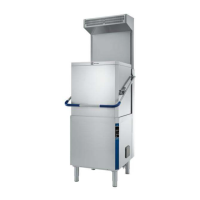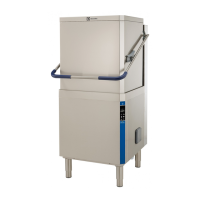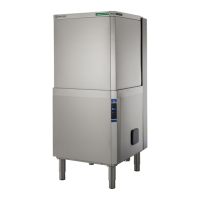29
• Select the parameter
• modify the parameter value
Press the button ("L" - Table 2 Control panel) to store
the set value.
To exit the programming mode, press the Wash cycle 3
button (“I” - Table 2 “Control panel”).
External dispenser adjustment
With external dispensers, it may be more useful to
have the parameters expressed in seconds, setting the
parameter to =seconds. In this way the
value of the parameters represents the duration in
seconds.
Listed below are special values usable when external
automatic dispensers are connected to the equipment
:
-if the detergent dispenser only
operates during
wash pump operation; terminals
7-9 of the main terminal board are powered at the
same time.
-if the detergent dispenser only
operates during
filling electrovalve operation for
restoring the boiler level; terminals
7-9 of the main
terminal board are powered at the same time.
-if the rinse-aid dispenser only
operates during
filling electrovalve operation for
restoring the boiler level; terminals
8-9 of the main
terminal board are powered at the same time.
-if the rinse-aid dispenser only operates
during
wash pump operation; terminals 8-9 of the
main terminal board are powered at the same time.
For connections, see the wiring diagram.
Example 1:
Supposing that an external detergent dispenser has
been connected with a tank concentration measuring
sensor, a standard setting could be as follows:
•
the parameter value is in seconds.
•
the dispenser is not activated during fill-
ing of the tank.
•
the dispenser is activated during
wash pump operation and, according to the con-
centration of detergent detected by the sensor, the
correct amount of detergent is dispensed.
Example 2:
Supposing that an external rinse-aid dispenser has
been connected with a tank concentration measuring
sensor, a standard setting could be as follows:
•
the parameter value is in seconds.
•
the dispenser is activated at each wash
cycle simultaneously with operation of the filling
solenoid valve. In this way avoiding modifications to
the wiring of the machine.
Suggestion: to check the effectiveness of the rinse-
aid, look at freshly washed glasses against the light.
Drops of water remaining on the glass indicate an
insufficient amount while streaks indicate an excess.
Changing the detergent/rinse-aid type.
If changing to a different detergent/rinse-aid type
(even one by the same manufacturer), you must rinse
the suction and pressure hoses with fresh water before
connecting the new detergent/rinse-aid container.
The mixing of different types of detergent/rinse-aid
will cause crystallisation, which may result in a
breakdown of the dosing pump. Failure to observe
this condition will invalidate the guarantee and
product liability.
